-
 Bitcoin
Bitcoin $105,495.4180
-0.21% -
 Ethereum
Ethereum $2,532.9701
-1.05% -
 Tether USDt
Tether USDt $1.0005
0.01% -
 XRP
XRP $2.1427
0.09% -
 BNB
BNB $644.0034
-1.52% -
 Solana
Solana $144.7535
-1.76% -
 USDC
USDC $0.9999
0.01% -
 Dogecoin
Dogecoin $0.1782
-0.48% -
 TRON
TRON $0.2709
-0.07% -
 Cardano
Cardano $0.6254
-2.05% -
 Hyperliquid
Hyperliquid $40.1521
-5.43% -
 Sui
Sui $2.9303
-4.30% -
 Chainlink
Chainlink $13.1995
-0.78% -
 Bitcoin Cash
Bitcoin Cash $433.3943
-1.08% -
 UNUS SED LEO
UNUS SED LEO $9.0813
1.24% -
 Avalanche
Avalanche $19.0345
-1.30% -
 Stellar
Stellar $0.2565
-1.39% -
 Toncoin
Toncoin $2.9571
-1.79% -
 Shiba Inu
Shiba Inu $0.0...01208
0.26% -
 Hedera
Hedera $0.1551
-1.85% -
 Litecoin
Litecoin $85.3588
-0.43% -
 Polkadot
Polkadot $3.7914
-0.78% -
 Ethena USDe
Ethena USDe $1.0004
0.00% -
 Monero
Monero $311.9380
0.64% -
 Dai
Dai $0.9999
0.02% -
 Bitget Token
Bitget Token $4.5248
0.11% -
 Pepe
Pepe $0.0...01097
-1.27% -
 Uniswap
Uniswap $7.2924
-2.89% -
 Pi
Pi $0.6092
5.31% -
 Aave
Aave $278.0189
-2.37%
What does the entanglement of +DI and -DI in the DMI indicator indicate? How to predict the direction of consolidation breakthrough?
When +DI and -DI entangle, it signals market indecision, often leading to consolidation or a potential breakout once momentum resumes.
Jun 14, 2025 at 10:42 am
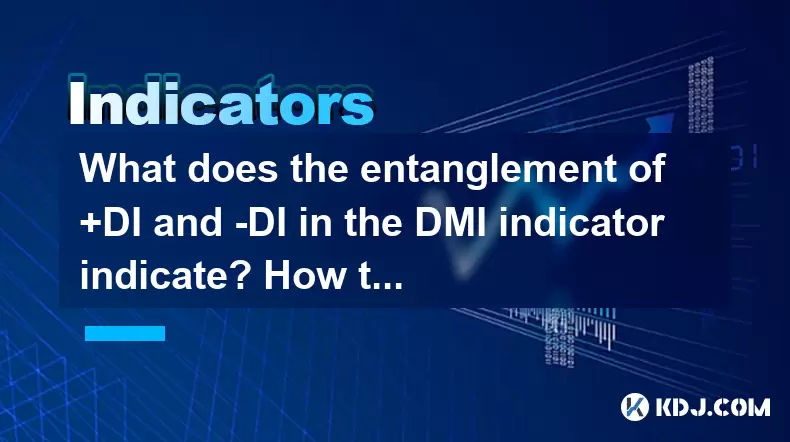
Understanding the DMI Indicator and Its Components
The Directional Movement Index (DMI) is a technical analysis tool designed to identify the direction and strength of a trend. It consists of two primary components: +DI (Positive Directional Indicator) and -DI (Negative Directional Indicator). These lines help traders determine whether an asset is trending upward or downward, as well as the strength of that movement.
+DI measures the strength of upward price movement, while -DI reflects the strength of downward movement. When these two lines are far apart, it typically indicates a strong trend in the direction of the dominant line. However, when +DI and -DI become entangled or closely intertwined, it suggests a period of indecision in the market.
What Does Entanglement of +DI and -DI Signify?
When +DI and -DI lines move very close together for an extended period, this entanglement signals market consolidation or a potential reversal. During such phases, neither buyers nor sellers are able to gain significant control, leading to sideways price action.
This condition often occurs after a strong trend has ended, where momentum diminishes and both directional indicators lose separation. The entanglement does not necessarily mean a reversal is imminent, but rather that the market is in a state of equilibrium, waiting for new information or catalysts to drive prices in one direction or the other.
In practical terms, traders should watch for a breakout from this consolidation phase, which can be identified by a decisive cross of either +DI above -DI (suggesting bullish momentum) or -DI above +DI (indicating bearish pressure).
Identifying Breakout Signals from Consolidation
To predict the direction of a consolidation breakout using the DMI indicator, traders must closely monitor the relationship between +DI and -DI as well as the ADX (Average Directional Index) line, which measures the strength of the trend regardless of direction.
Here are key steps to analyze potential breakouts:
- Observe the narrowing gap between +DI and -DI: As the two lines converge, it indicates weakening momentum and possible consolidation.
- Monitor ADX levels: If ADX rises during this convergence, it may signal that a trend is about to resume. A rising ADX above 25 typically indicates increasing trend strength.
- Watch for crossovers: A crossover of +DI above -DI could indicate a bullish breakout, while the opposite suggests a bearish move is likely.
- Confirm with price action: Always look at candlestick patterns or support/resistance levels to confirm any signals given by the DMI indicator.
- Use volume indicators: An increase in trading volume during a breakout can provide additional confirmation that the move is genuine and not a false signal.
Using Price Patterns Alongside DMI for Confirmation
Price patterns such as triangles, rectangles, or flags can often form during periods of consolidation. Combining these patterns with DMI readings enhances the accuracy of breakout predictions.
For instance, if a cryptocurrency is forming a symmetrical triangle on the chart and +DI begins to rise slightly above -DI, it may suggest a potential bullish breakout. Conversely, if -DI gains strength during the pattern formation, a bearish breakout becomes more likely.
Traders should also pay attention to key psychological levels or previous support/resistance zones near the breakout point. These areas can act as natural barriers or launchpads for price movements once they are decisively broken.
Additionally, applying other tools like moving averages or Fibonacci retracement levels can help identify target zones for price after a breakout.
Practical Application in Cryptocurrency Trading
In the volatile world of cryptocurrencies, identifying consolidation phases and predicting breakouts is crucial for timing entries and exits effectively.
For example, consider Bitcoin trading in a tight range for several days. On the DMI chart, both +DI and -DI lines are tightly bound together, indicating no clear direction. Suddenly, the ADX line starts to rise, suggesting that a trend is forming. If +DI crosses above -DI shortly afterward, it may signal the start of a new uptrend.
Traders can then look to enter long positions once the price breaks above the upper boundary of the consolidation zone. Setting stop-loss orders just below the recent swing low helps manage risk.
Alternatively, if -DI crosses above +DI during this phase, traders might consider shorting opportunities, especially if the price falls below key support levels.
Frequently Asked Questions
Q: Can I rely solely on the DMI indicator for trading decisions?
A: While DMI is a powerful tool, it works best when combined with other forms of analysis such as price action, volume indicators, and support/resistance levels.
Q: How do I adjust DMI settings for different cryptocurrencies?
A: The default setting for DMI is 14 periods, but you can experiment with shorter timeframes (e.g., 7 or 10) for more sensitivity in fast-moving crypto markets. However, shorter periods may produce more false signals.
Q: What does it mean if ADX is falling while +DI and -DI remain entangled?
A: A declining ADX line during entanglement suggests that the market lacks a strong trend and may continue consolidating for some time.
Q: Should I always wait for a DI crossover before entering a trade?
A: Not necessarily. Some traders prefer to use the proximity of +DI and -DI as an early warning sign and combine it with candlestick patterns or volume spikes to anticipate a breakout before the actual crossover occurs.
Disclaimer:info@kdj.com
The information provided is not trading advice. kdj.com does not assume any responsibility for any investments made based on the information provided in this article. Cryptocurrencies are highly volatile and it is highly recommended that you invest with caution after thorough research!
If you believe that the content used on this website infringes your copyright, please contact us immediately (info@kdj.com) and we will delete it promptly.
- Explore the Best Upcoming Crypto Presales
- 2025-06-15 05:55:13
- Diverging Trends in the Precious Metals Market
- 2025-06-15 05:55:13
- Maelstrom CIO Arthur Hayes Predicts Bitcoin Price Will Reach $1 Million by 2028
- 2025-06-15 05:50:13
- XYZVerse ($XYZ) has brought a brand-new concept to the memecoin niche by blending the excitement of sports with the fast-moving energy of crypto.
- 2025-06-15 05:50:13
- Bitcoin (BTC) Price Action Is Trapped Within a Tight Trading Channel
- 2025-06-15 05:45:13
- The entire cryptocurrency market is bracing for a major move after Bitcoin recently reached the crucial $95,000 mark before declining to the $90000 level.
- 2025-06-15 05:45:13
Related knowledge
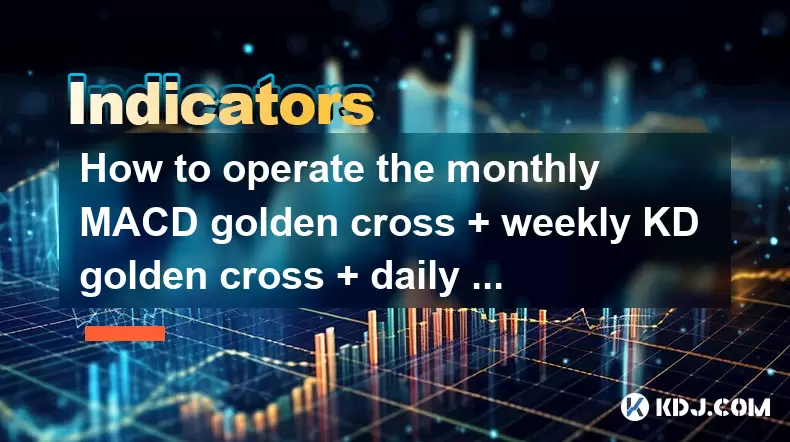
How to operate the monthly MACD golden cross + weekly KD golden cross + daily volume breakthrough?
Jun 15,2025 at 05:36am
Understanding the Strategy: Monthly MACD Golden CrossTo effectively operate the monthly MACD golden cross, traders must first understand what this signal entails. The MACD (Moving Average Convergence Divergence) golden cross occurs when the MACD line crosses above the signal line on a given chart timeframe. When this happens on the monthly chart, it sug...
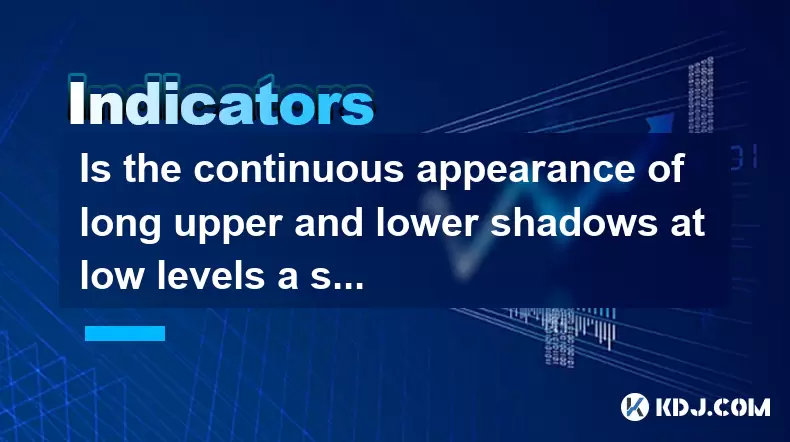
Is the continuous appearance of long upper and lower shadows at low levels a signal of accumulation?
Jun 15,2025 at 01:43am
Understanding Long Upper and Lower Shadows in Candlestick ChartsIn the world of cryptocurrency trading, candlestick patterns are widely used to analyze price movements. A long upper shadow, also known as a wick or tail, indicates that the price rose significantly during the period but was pushed back down by selling pressure. Conversely, a long lower sh...
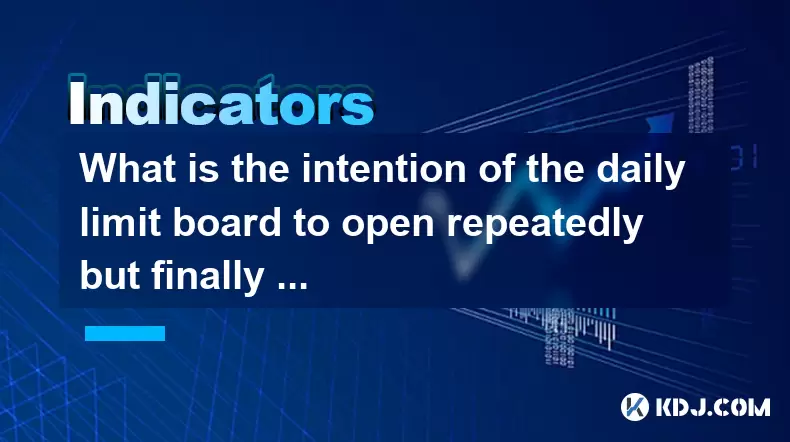
What is the intention of the daily limit board to open repeatedly but finally close?
Jun 15,2025 at 01:08am
Understanding the Daily Limit Board in Cryptocurrency TradingIn cryptocurrency trading, a daily limit board refers to a price movement restriction mechanism applied by certain exchanges or regulatory bodies. This mechanism is primarily used to prevent extreme volatility and panic selling or buying during periods of intense market fluctuation. When an as...

How to calculate the probability of trend continuation after the MACD column divergence?
Jun 14,2025 at 08:01am
Understanding MACD Column DivergenceThe Moving Average Convergence Divergence (MACD) is a widely used technical indicator in cryptocurrency trading. The MACD column, also known as the histogram, represents the difference between the MACD line and the signal line. When price makes a new high or low but the MACD histogram does not confirm this movement, a...
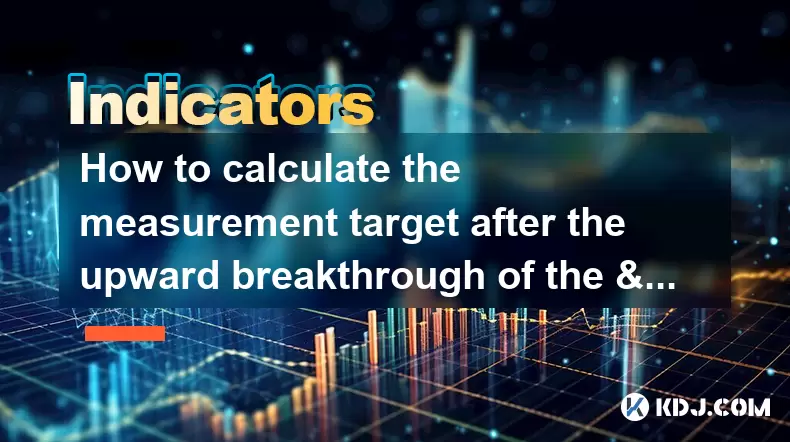
How to calculate the measurement target after the upward breakthrough of the "descending wedge"?
Jun 15,2025 at 05:00am
Understanding the Descending Wedge PatternA descending wedge is a technical analysis pattern typically found in price charts of cryptocurrencies. It is characterized by two converging trendlines: one drawn along a series of lower highs (resistance) and another connecting a series of higher lows (support). This pattern usually indicates a potential bulli...

What are the volume requirements for adjusting the K line in the "rising three methods" pattern?
Jun 14,2025 at 07:50am
Understanding the 'Rising Three Methods' Pattern in Cryptocurrency TradingThe 'rising three methods' pattern is a bullish continuation candlestick formation that traders often use to identify potential upward momentum in cryptocurrency price charts. This pattern typically appears during an uptrend and suggests that the trend is likely to continue after ...

How to operate the monthly MACD golden cross + weekly KD golden cross + daily volume breakthrough?
Jun 15,2025 at 05:36am
Understanding the Strategy: Monthly MACD Golden CrossTo effectively operate the monthly MACD golden cross, traders must first understand what this signal entails. The MACD (Moving Average Convergence Divergence) golden cross occurs when the MACD line crosses above the signal line on a given chart timeframe. When this happens on the monthly chart, it sug...

Is the continuous appearance of long upper and lower shadows at low levels a signal of accumulation?
Jun 15,2025 at 01:43am
Understanding Long Upper and Lower Shadows in Candlestick ChartsIn the world of cryptocurrency trading, candlestick patterns are widely used to analyze price movements. A long upper shadow, also known as a wick or tail, indicates that the price rose significantly during the period but was pushed back down by selling pressure. Conversely, a long lower sh...

What is the intention of the daily limit board to open repeatedly but finally close?
Jun 15,2025 at 01:08am
Understanding the Daily Limit Board in Cryptocurrency TradingIn cryptocurrency trading, a daily limit board refers to a price movement restriction mechanism applied by certain exchanges or regulatory bodies. This mechanism is primarily used to prevent extreme volatility and panic selling or buying during periods of intense market fluctuation. When an as...

How to calculate the probability of trend continuation after the MACD column divergence?
Jun 14,2025 at 08:01am
Understanding MACD Column DivergenceThe Moving Average Convergence Divergence (MACD) is a widely used technical indicator in cryptocurrency trading. The MACD column, also known as the histogram, represents the difference between the MACD line and the signal line. When price makes a new high or low but the MACD histogram does not confirm this movement, a...

How to calculate the measurement target after the upward breakthrough of the "descending wedge"?
Jun 15,2025 at 05:00am
Understanding the Descending Wedge PatternA descending wedge is a technical analysis pattern typically found in price charts of cryptocurrencies. It is characterized by two converging trendlines: one drawn along a series of lower highs (resistance) and another connecting a series of higher lows (support). This pattern usually indicates a potential bulli...

What are the volume requirements for adjusting the K line in the "rising three methods" pattern?
Jun 14,2025 at 07:50am
Understanding the 'Rising Three Methods' Pattern in Cryptocurrency TradingThe 'rising three methods' pattern is a bullish continuation candlestick formation that traders often use to identify potential upward momentum in cryptocurrency price charts. This pattern typically appears during an uptrend and suggests that the trend is likely to continue after ...
See all articles

























































































